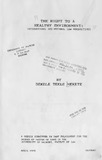| dc.description.abstract | This study focuses on a new fundamental human right in the making, the right to a healthy environment. Encroaching environmental pollution problems called for the creation of a link between human rights protection and the protection of the environment. Attempts have been made to show the importance of this relationship. Chapter One sets out the scheme of the study. The subject matter of the study, a healthy environment, is defined here. Statement of the problem, theoretical framework, literature review, objectives, scope and methodology of the study have been presented in this Chapter.
Chapter Two concentrates on the dimension of human rights and its determining criteria, with a view to classifying the right to a healthy environment as such. Historical and evolutionary development of human rights have been discussed in terms of 'generations' of human rights. Three generations of human rights.' first, second and third, have been identified as categories of human rights. The right to a heal thy environment falls wi thin the category of 'third generation' human rights, whose subjects are mainly groups and peoples. Based on the criteria for determining a fundamental human right, this right is argued to be a theoretically valid human right.
The international and national perspectives of the right to a healthy environment have been dealt with in Chapter Three of the study. The examination and analysis of the existing international human rights conventions and national constitutions tend to show that environmental rights are fundamental human rights of primordial importance. Chapter Four deals with environmental dispute settlement. Using a comparative approach, some of the most important international and national environmental rights cases have been discussed. Based on the findings of the study, Chapter Five contains the conclusions and recommendations. It is concluded that the right to a heal thy environment is partly accepted as a fundamental human right, and partly lacking universal recognition. It is found that the existing international dispute settlement institutions discourage individual and group environmental rights litigations. Accordingly, appropriate recommendations are made to rectify the anomalies encountered in the course of the study. | en_US |

